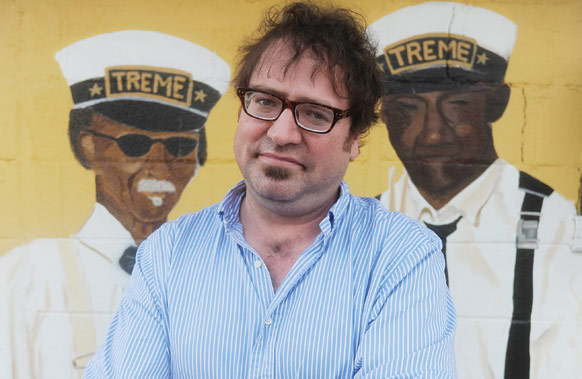
IRIS login | Reed College home Volume 90, No. 2: June 2011
The Showman’s Doppelganger

Photo by David Rae Morris
The HBO drama Treme features a lead character based on flamboyant New Orleans jazzman Davis Rogan ’90. Or is it the other way around?
By Mike Perlstein ’84
Alright, well, the apartment is messy.
And the girls, they aren’t as fine (in the classic Hollywood sense).
I’d like to think I’m a bit dressier
And I know more about wine.
I get tired of explaining what really happened
So I sat down and wrote these lines.
—“The Real Davis” by Davis Rogan.
It’s a strange and heady experience being the real Davis Rogan these days, floating somewhere in the metaphysical space where Marshall McLuhan’s warning that the medium is the message overlaps with Andy Warhol’s 15 minutes of fame. But it turns out that’s a great career trajectory for a piano-playing Reedie from New Orleans.
Especially when those 15 minutes promise to stretch into five seasons as a creative muse for the one of the most critically acclaimed television shows of the past few years: the HBO series Treme, created by David Simon and Eric Overmyer ’73 (who also brought you the HBO hit show The Wire).
“Never do things happen on merit in the music business,” Davis quips, “except this time.”
Officially, his title for the show is “consultant.” It’s a role that covers a lot of ground: a guest script writer, an occasional songsmith, and a recurring cameo as a musical sideman named “Rogan.” But his fun-house mirror stroke of fame comes from being the inspiration for lead character Davis McAlary.
In the show, McAlary—the TV Davis—mimics his real-life counterpart in many respects: the cluttered apartment, the wrinkled, untucked gingham shirts, the soul patch and unkempt hair, the rapid-fire wit, and the outsized personality that is sometimes charming, sometimes annoying, and always in your face.
The show takes plenty of poetic license, of course, stretching stories and doctoring details for entertainment value. The real Davis comes from a middle-class background provided by his father, a petroleum engineer, and his housewife mother, who raised four children before she died at 42 of an aneurysm. The TV Davis comes from old Uptown money, often embarrassing his family with his black sheep antics.
The real Davis was fired from the radio station WWOZ for playing too much hip-hop. The TV Davis is fired for staging the voodoo sacrifice of a chicken on the air by mojo musician Coco Robicheaux. The real Davis is taller.
Nonetheless, the parallels are striking, even occasionally uncomfortable, such as when the TV Davis, after hours of carousing, goes right up to the edge of losing control.
But Davis doesn’t seem to mind.
“It’s just a surreal twist in an already surreal life,” he says. “But I’m really too closely involved to have any perspective. It’s like watching your hair grow.”
Set in the rubble of post-Katrina New Orleans, Treme takes its title from a deeply historic and musically rich Creole enclave bordering the French Quarter. Decades of neglect kept the neighborhood under the radar and off the tourism trail, which helped it maintain its pure cultural roots. It was a place where brass bands drew raucous crowds at ramshackle nightclubs, second-line parades would break out at the drop of a feathered fedora, and a close-knit sense of community softened the jagged edge of persistent poverty.
The show tracks a loosely connected cast of New Orleans characters—including a chef, a Mardi Gras Indian chief, a civil rights attorney, a trombone player, and the roguish Davis—as they rebuild their lives after the hurricane. The show hits notes that are familiar (government ineptitude, police brutality, celebration of food and music) and others that are considered part of the Big Easy exotica (jazz funerals and second lines, the mysterious culture of the Mardi Gras Indians, the nuances of the city’s Mardi Gras traditions). Sure, there’s plot-driven suspense involving relationships, unsolved Katrina deaths, and surviving in a disaster zone, but the show also features the kind of artistic license that has garnered widespread critical acclaim and a cult-type audience. Music is a driving force throughout the series, and many episodes include long, artful tracking shots of New Orleans musicians going to town, whether it’s in the studio, a Mardi Gras Indian practice, or a freewheeling street parade.
USA Today called it “the soundtrack of New Orleans.” Alessandra Stanley of the New York Times wrote, “Treme is most of all a story about survival—and the pursuit of pleasure—in the wake of a catastrophe that quickly morphed into, as one character puts it, ‘federally induced disaster.’”
One half of the show’s brain trust is former newspaper reporter David Simon, who created the HBO hit series The Wire. The other half is Eric Overmyer ’73, a veteran playwright and scriptwriter who credits his days at Reed for helping him find his literary identity.
Even before the hurricane, Simon and Overmyer had talked about doing a show based on the music and culture of New Orleans. After Katrina, the city seemed like an ideal backdrop for an urban drama. Simon began soaking up everything he could about the city. One day he was reading Offbeat, a New Orleans music magazine, and stumbled across a glowing review of a local album titled Once and Future DJ. He bought the CD, loved it, and, pulling from many of the autobiographical lyrics, began envisioning a character based on the DJ—who was, of course, Davis.


LATEST COMMENTS
steve-jobs-1976 I knew Steve Jobs when he was on the second floor of Quincy. (Fall...
Utnapishtim - 2 weeks ago
Prof. Mason Drukman [political science 1964–70] This is gold, pure gold. God bless, Prof. Drukman.
puredog - 1 month ago
virginia-davis-1965 Such a good friend & compatriot in the day of Satyricon...
czarchasm - 4 months ago
John Peara Baba 1990 John died of a broken heart from losing his mom and then his...
kodachrome - 7 months ago
Carol Sawyer 1962 Who wrote this obit? I'm writing something about Carol Sawyer...
MsLaurie Pepper - 8 months ago
William W. Wissman MAT 1969 ...and THREE sisters. Sabra, the oldest, Mary, the middle, and...
riclf - 10 months ago